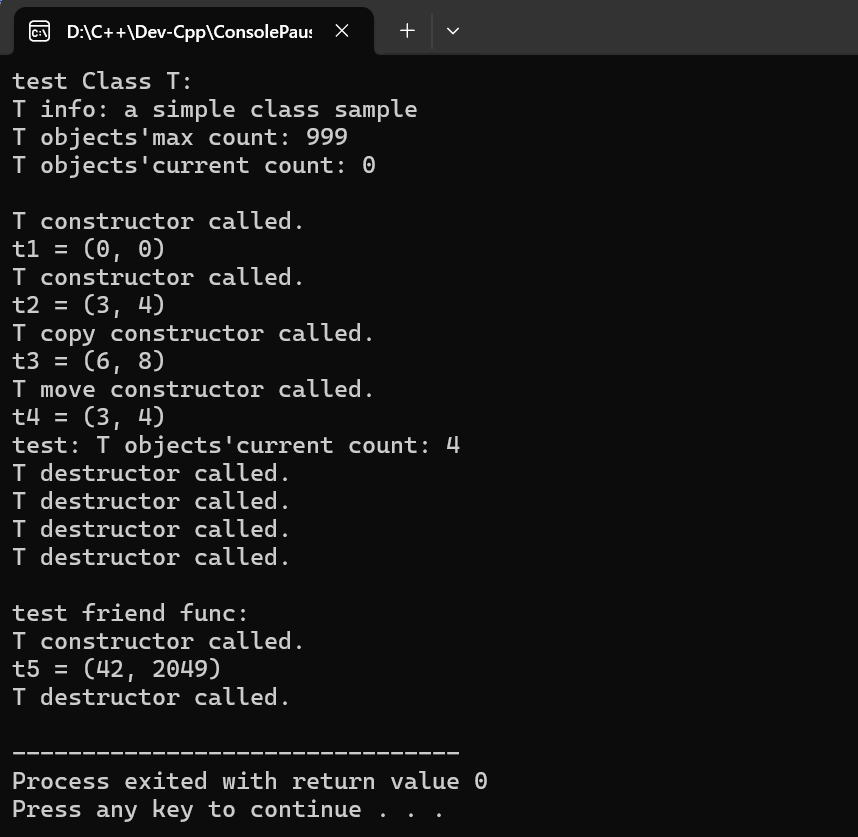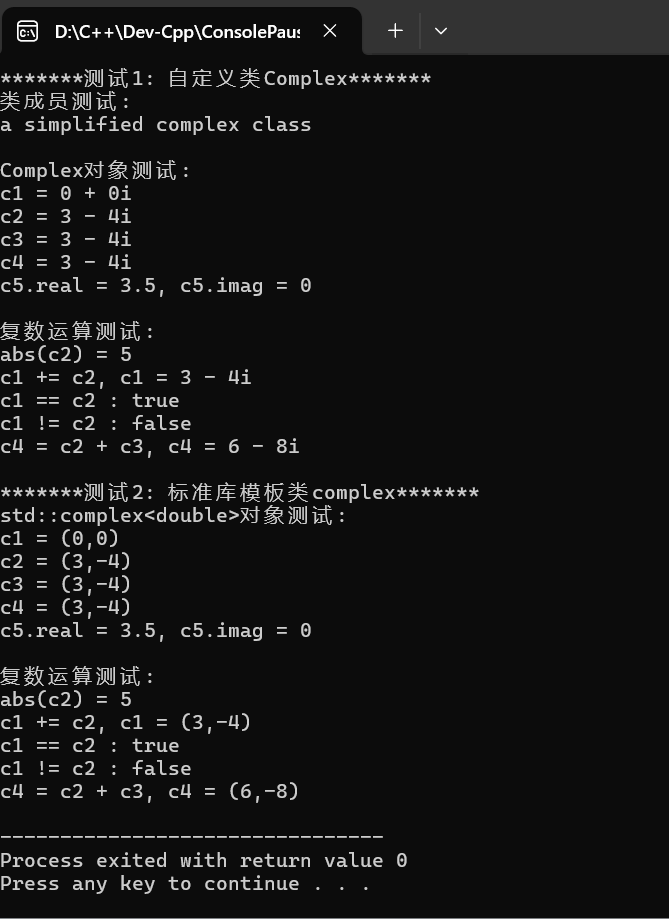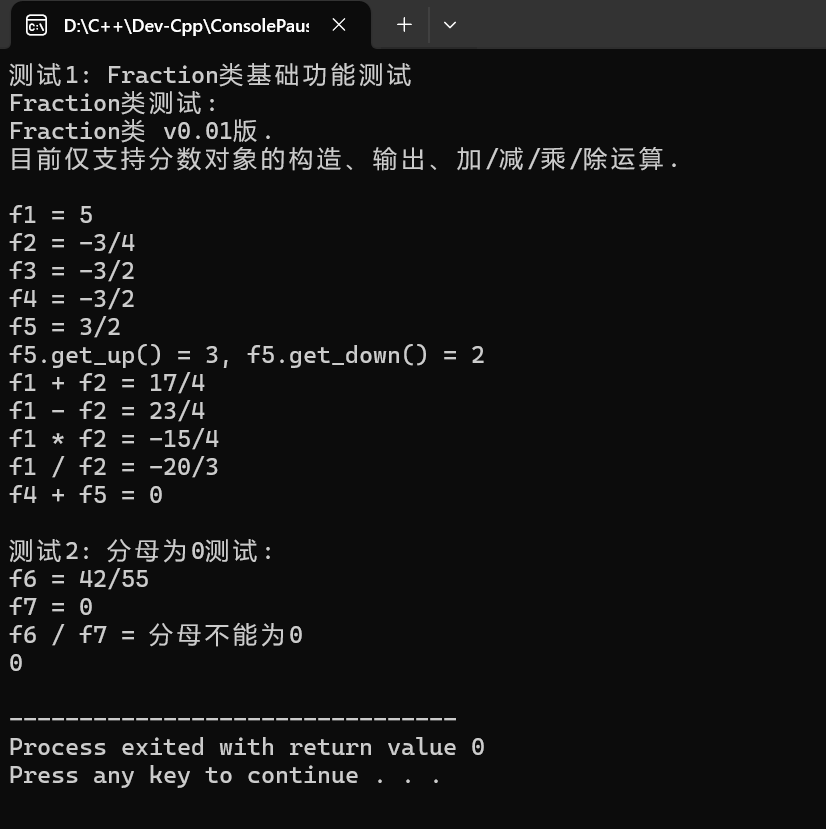实验2
##实验任务1
##代码
##T.h
1 #pragma once 2 3 #include <string> 4 5 // 类T: 声明 6 class T { 7 // 对象属性、方法 8 public: 9 T(int x = 0, int y = 0); // 普通构造函数 10 T(const T &t); // 复制构造函数 11 T(T &&t); // 移动构造函数 12 ~T(); // 析构函数 13 14 void adjust(int ratio); // 按系数成倍调整数据 15 void display() const; // 以(m1, m2)形式显示T类对象信息 16 17 private: 18 int m1, m2; 19 20 // 类属性、方法 21 public: 22 static int get_cnt(); // 显示当前T类对象总数 23 24 public: 25 static const std::string doc; // 类T的描述信息 26 static const int max_cnt; // 类T对象上限 27 28 private: 29 static int cnt; // 当前T类对象数目 30 31 // 类T友元函数声明 32 friend void func(); 33 }; 34 35 // 普通函数声明 36 void func();
##T.cpp
1 #include "T.h" 2 #include <iostream> 3 #include <string> 4 5 // 类T实现 6 7 // static成员数据类外初始化 8 const std::string T::doc{"a simple class sample"}; 9 const int T::max_cnt = 999; 10 int T::cnt = 0; 11 12 // 类方法 13 int T::get_cnt() { 14 return cnt; 15 } 16 17 // 对象方法 18 T::T(int x, int y): m1{x}, m2{y} { 19 ++cnt; 20 std::cout << "T constructor called.\n"; 21 } 22 23 T::T(const T &t): m1{t.m1}, m2{t.m2} { 24 ++cnt; 25 std::cout << "T copy constructor called.\n"; 26 } 27 28 T::T(T &&t): m1{t.m1}, m2{t.m2} { 29 ++cnt; 30 std::cout << "T move constructor called.\n"; 31 } 32 33 T::~T() { 34 --cnt; 35 std::cout << "T destructor called.\n"; 36 } 37 38 void T::adjust(int ratio) { 39 m1 *= ratio; 40 m2 *= ratio; 41 } 42 43 void T::display() const { 44 std::cout << "(" << m1 << ", " << m2 << ")" ; 45 } 46 47 // 普通函数实现 48 void func() { 49 T t5(42); 50 t5.m2 = 2049; 51 std::cout << "t5 = "; t5.display(); std::cout << '\n'; 52 }
##task1.cpp
1 #include "T.h" 2 #include <iostream> 3 4 void test_T(); 5 6 int main() { 7 std::cout << "test Class T: \n"; 8 test_T(); 9 10 std::cout << "\ntest friend func: \n"; 11 func(); 12 } 13 14 void test_T() { 15 using std::cout; 16 using std::endl; 17 18 cout << "T info: " << T::doc << endl; 19 cout << "T objects'max count: " << T::max_cnt << endl; 20 cout << "T objects'current count: " << T::get_cnt() << endl << endl; 21 22 T t1; 23 cout << "t1 = "; t1.display(); cout << endl; 24 25 T t2(3, 4); 26 cout << "t2 = "; t2.display(); cout << endl; 27 28 T t3(t2); 29 t3.adjust(2); 30 cout << "t3 = "; t3.display(); cout << endl; 31 32 T t4(std::move(t2)); 33 cout << "t4 = "; t4.display(); cout << endl; 34 35 cout << "test: T objects'current count: " << T::get_cnt() << endl; 36 }
##运行结果

##问题1
Yes
##问题2
普通构造函数 功能:初始化对象的数据成员,为对象分配必要的资源 调用时机:创建新对象时
复制构造函数 功能:通过拷贝另一个同类对象来初始化新对象 调用时机:用已有对象初始化新对象时:T obj1; T obj2(obj1); 对象作为值参数传递给函数时
移动构造函数 功能:通过"窃取"另一个临时对象的资源来初始化新对象 调用时机:用右值(临时对象)初始化新对象时:T obj1; T obj2(std::move(obj1))
析构函数 功能:释放对象占用的资源 调用时机:对象生命周期结束时;对对象调用delete操作时
##问题3
能正确编译
##实验任务2
##代码
##Complex.h
1 #ifndef COMPLEX_H 2 #define COMPLEX_H 3 4 #include <string> 5 6 class Complex { 7 public: 8 static const std::string doc; // 类说明文档 9 10 // 构造函数 11 Complex(); // 默认构造函数,创建0+0i 12 Complex(double real); // 用实部创建复数,虚部为0 13 Complex(double real, double imag); // 用实部和虚部创建复数 14 Complex(const Complex& other); // 拷贝构造函数 15 16 // 成员函数 17 double get_real() const; // 获取实部 18 double get_imag() const; // 获取虚部 19 void add(const Complex& other); // 复数加法,相当于+= 20 21 // 友元函数 22 friend void output(const Complex& c); // 输出复数 23 friend double abs(const Complex& c); // 取模 24 friend Complex add(const Complex& c1, const Complex& c2); // 复数相加 25 friend bool is_equal(const Complex& c1, const Complex& c2); // 判断相等 26 friend bool is_not_equal(const Complex& c1, const Complex& c2); // 判断不等 27 28 private: 29 double real_; // 实部 30 double imag_; // 虚部 31 }; 32 33 #endif // COMPLEX_H
##Complex.cpp
1 #include "Complex.h" 2 #include <iostream> 3 #include <cmath> 4 5 using namespace std; 6 7 // 类说明文档定义 8 const string Complex::doc = "a simplified complex class"; 9 10 // 默认构造函数 11 Complex::Complex() : real_(0.0), imag_(0.0) {} 12 13 // 用实部创建复数 14 Complex::Complex(double real) : real_(real), imag_(0.0) {} 15 16 // 用实部和虚部创建复数 17 Complex::Complex(double real, double imag) : real_(real), imag_(imag) {} 18 19 // 拷贝构造函数 20 Complex::Complex(const Complex& other) : real_(other.real_), imag_(other.imag_) {} 21 22 // 获取实部 23 double Complex::get_real() const { 24 return real_; 25 } 26 27 // 获取虚部 28 double Complex::get_imag() const { 29 return imag_; 30 } 31 32 // 复数加法(相当于+=) 33 void Complex::add(const Complex& other) { 34 real_ += other.real_; 35 imag_ += other.imag_; 36 } 37 38 // 输出复数(友元函数) 39 void output(const Complex& c) { 40 cout << c.real_; 41 if (c.imag_ >= 0) { 42 cout << " + " << c.imag_ << "i"; 43 } else { 44 cout << " - " << -c.imag_ << "i"; 45 } 46 } 47 48 // 取模(友元函数) 49 double abs(const Complex& c) { 50 return sqrt(c.real_ * c.real_ + c.imag_ * c.imag_); 51 } 52 53 // 复数相加(友元函数) 54 Complex add(const Complex& c1, const Complex& c2) { 55 return Complex(c1.real_ + c2.real_, c1.imag_ + c2.imag_); 56 } 57 58 // 判断相等(友元函数) 59 bool is_equal(const Complex& c1, const Complex& c2) { 60 return (c1.real_ == c2.real_) && (c1.imag_ == c2.imag_); 61 } 62 63 // 判断不等(友元函数) 64 bool is_not_equal(const Complex& c1, const Complex& c2) { 65 return !is_equal(c1, c2); 66 }
##task2.cpp
1 #include "Complex.h" 2 #include <iostream> 3 #include <iomanip> 4 #include <complex> 5 6 using namespace std; 7 8 void test_Complex(); 9 void test_std_complex(); 10 11 int main() { 12 cout << "*******测试1: 自定义类Complex*******\n"; 13 test_Complex(); 14 cout << "\n*******测试2: 标准库模板类complex*******\n"; 15 test_std_complex(); 16 return 0; 17 } 18 19 void test_Complex() { 20 using std::cout; 21 using std::endl; 22 using std::boolalpha; 23 24 cout << "类成员测试: " << endl; 25 cout << Complex::doc << endl << endl; 26 27 cout << "Complex对象测试: " << endl; 28 Complex c1; 29 Complex c2(3, -4); 30 Complex c3(c2); 31 Complex c4 = c2; 32 const Complex c5(3.5); 33 34 cout << "c1 = "; output(c1); cout << endl; 35 cout << "c2 = "; output(c2); cout << endl; 36 cout << "c3 = "; output(c3); cout << endl; 37 cout << "c4 = "; output(c4); cout << endl; 38 cout << "c5.real = " << c5.get_real() 39 << ", c5.imag = " << c5.get_imag() << endl << endl; 40 41 cout << "复数运算测试: " << endl; 42 cout << "abs(c2) = " << abs(c2) << endl; 43 c1.add(c2); 44 cout << "c1 += c2, c1 = "; output(c1); cout << endl; 45 cout << boolalpha; 46 cout << "c1 == c2 : " << is_equal(c1, c2) << endl; 47 cout << "c1 != c2 : " << is_not_equal(c1, c2) << endl; 48 c4 = add(c2, c3); 49 cout << "c4 = c2 + c3, c4 = "; output(c4); cout << endl; 50 } 51 52 void test_std_complex() { 53 using std::cout; 54 using std::endl; 55 using std::boolalpha; 56 57 cout << "std::complex<double>对象测试: " << endl; 58 std::complex<double> c1; 59 std::complex<double> c2(3, -4); 60 std::complex<double> c3(c2); 61 std::complex<double> c4 = c2; 62 const std::complex<double> c5(3.5); 63 64 cout << "c1 = " << c1 << endl; 65 cout << "c2 = " << c2 << endl; 66 cout << "c3 = " << c3 << endl; 67 cout << "c4 = " << c4 << endl; 68 cout << "c5.real = " << c5.real() 69 << ", c5.imag = " << c5.imag() << endl << endl; 70 71 cout << "复数运算测试: " << endl; 72 cout << "abs(c2) = " << abs(c2) << endl; 73 c1 += c2; 74 cout << "c1 += c2, c1 = " << c1 << endl; 75 cout << boolalpha; 76 cout << "c1 == c2 : " << (c1 == c2) << endl; 77 cout << "c1 != c2 : " << (c1 != c2) << endl; 78 c4 = c2 + c3; 79 cout << "c4 = c2 + c3, c4 = " << c4 << endl; 80 }
##运行结果

##问题1
标准库模板类complex明显更简洁,标准库使用自然的数学运算符,自定义类complex需要专门的输出函数;
函数和运算在功能上是完全等价的,只是标准库的写法更接近数学表达式,直观易懂,标准库的设计通过运算符重载实现了更优雅的语法。
##问题2
2.1是,列如,如果仅通过 get_real()和 get_imag()获取数据,output()需要额外逻辑拼接字符串,不如直接访问私有变量高效,如果不直接访问私有数据,可能会导致性能损失,代码冗余,封装性降低等,因此,友元函数是合理的设计选择。
2.2标准库 std::complex没有将 abs()设为友元函数,std::abs(std::complex)是独立函数,它不依赖友元访问 std::complex的私有数据,而是通过 real()和 imag()这两个公共成员函数获取实部和虚部。
2.3需要访问私有数据,但无法通过公有接口高校实现;需要支持运算符重载,但运算符函数不能是成员。
##问题3
Complex c4 = c2是拷贝初始化,如果编译失败,那么使用直接初始化Complex c3(c2)。
##实验任务3
##代码
##PlayControl.h
1 #pragma once 2 #include <string> 3 enum class ControlType {Play, Pause, Next, Prev, Stop, Unknown}; 4 class PlayerControl { 5 public: 6 PlayerControl(); 7 ControlType parse(const std::string& control_str); // 实现std::string --> ControlType转换 8 void execute(ControlType cmd) const; // 执行控制操作(以打印输出模拟) 9 static int get_cnt(); 10 private: 11 static int total_cnt; 12 };
##PlayControl.cpp
1 #include "PlayerControl.h" 2 #include <iostream> 3 #include <algorithm> 4 #include <cctype> 5 6 int PlayerControl::total_cnt = 0; 7 8 PlayerControl::PlayerControl() {} 9 10 ControlType PlayerControl::parse(const std::string& control_str) { 11 // 1. 将输入字符串转为小写(实现大小写不敏感) 12 std::string lower_str = control_str; 13 std::transform(lower_str.begin(), lower_str.end(), lower_str.begin(), 14 [](unsigned char c) { return std::tolower(c); }); 15 16 // 2. 匹配命令并返回对应枚举 17 ControlType cmd = ControlType::Unknown; 18 if (lower_str == "play") { 19 cmd = ControlType::Play; 20 } else if (lower_str == "pause") { 21 cmd = ControlType::Pause; 22 } else if (lower_str == "next") { 23 cmd = ControlType::Next; 24 } else if (lower_str == "prev") { 25 cmd = ControlType::Prev; 26 } else if (lower_str == "stop") { 27 cmd = ControlType::Stop; 28 } 29 30 // 3. 成功匹配时,递增总操作次数 31 if (cmd != ControlType::Unknown) { 32 total_cnt++; 33 } 34 35 return cmd; 36 } 37 38 void PlayerControl::execute(ControlType cmd) const { 39 switch (cmd) { 40 case ControlType::Play: 41 std::cout << "[play] Playing music...\n"; 42 break; 43 case ControlType::Pause: 44 std::cout << "[Pause] Music paused\n"; 45 break; 46 case ControlType::Next: 47 std::cout << "[Next] Skipping to next track\n"; 48 break; 49 case ControlType::Prev: 50 std::cout << "[Prev] Back to previous track\n"; 51 break; 52 case ControlType::Stop: 53 std::cout << "[Stop] Music stopped\n"; 54 break; 55 default: 56 std::cout << "[Error] unknown control\n"; 57 break; 58 } 59 } 60 61 int PlayerControl::get_cnt() { 62 return total_cnt; 63 }
##task3.cpp
1 #include "PlayerControl.h" 2 #include <iostream> 3 void test() { 4 PlayerControl controller; 5 std::string control_str; 6 std::cout << "Enter Control: (play/pause/next/prev/stop/quit):\n"; 7 while(std::cin >> control_str) { 8 if(control_str == "quit") 9 break; 10 11 ControlType cmd = controller.parse(control_str); 12 controller.execute(cmd); 13 std::cout << "Current Player control: " << PlayerControl::get_cnt() << "\n\n"; 14 } 15 } 16 int main(){ 17 test(); 18 }
##运行结果

##实验任务4
##代码
##Fraction.h
1 #ifndef FRACTION_H 2 #define FRACTION_H 3 4 #include <string> 5 6 class Fraction { 7 public: 8 // 类属性,用于类说明 9 static const std::string doc; 10 11 // 构造函数 12 Fraction(int up = 0, int down = 1); 13 Fraction(const Fraction& other); 14 15 // 接口 16 int get_up() const; 17 int get_down() const; 18 Fraction negative() const; 19 20 // 友元函数声明(工具函数) 21 friend void output(const Fraction& frac); 22 friend Fraction add(const Fraction& f1, const Fraction& f2); 23 friend Fraction sub(const Fraction& f1, const Fraction& f2); 24 friend Fraction mul(const Fraction& f1, const Fraction& f2); 25 friend Fraction div(const Fraction& f1, const Fraction& f2); 26 27 private: 28 // 对象属性:分子和分母 29 int up; 30 int down; 31 32 // 内部工具函数:化简分数 33 void simplify(); 34 // 内部工具函数:求最大公约数 35 int gcd(int a, int b); 36 }; 37 38 #endif // FRACTION_H
##Fraction.cpp
1 #include "Fraction.h" 2 #include <iostream> 3 4 // 初始化类属性 5 const std::string Fraction::doc = "Fraction类 v0.01版.\n目前仅支持分数对象的构造、输出、加/减/乘/除运算."; 6 7 // 构造函数 8 Fraction::Fraction(int up, int down) : up(up), down(down) { 9 if (down == 0) { 10 std::cerr << "分母不能为0" << std::endl; 11 // 分母为0时,默认初始化为0/1 12 this->up = 0; 13 this->down = 1; 14 } else { 15 simplify(); 16 } 17 } 18 19 // 拷贝构造函数 20 Fraction::Fraction(const Fraction& other) : up(other.up), down(other.down) {} 21 22 // 获取分子 23 int Fraction::get_up() const { 24 return up; 25 } 26 27 // 获取分母 28 int Fraction::get_down() const { 29 return down; 30 } 31 32 // 求负 33 Fraction Fraction::negative() const { 34 return Fraction(-up, down); 35 } 36 37 // 化简分数 38 void Fraction::simplify() { 39 if (up == 0) { 40 down = 1; 41 return; 42 } 43 int sign = 1; 44 if (up < 0) { 45 sign *= -1; 46 up = -up; 47 } 48 if (down < 0) { 49 sign *= -1; 50 down = -down; 51 } 52 int g = gcd(up, down); 53 up = sign * (up / g); 54 down = down / g; 55 } 56 57 // 求最大公约数 58 int Fraction::gcd(int a, int b) { 59 return b == 0 ? a : gcd(b, a % b); 60 } 61 62 // 输出分数 63 void output(const Fraction& frac) { 64 if (frac.down == 1) { 65 std::cout << frac.up; 66 } else { 67 std::cout << frac.up << "/" << frac.down; 68 } 69 } 70 71 // 分数相加 72 Fraction add(const Fraction& f1, const Fraction& f2) { 73 int up = f1.up * f2.down + f2.up * f1.down; 74 int down = f1.down * f2.down; 75 Fraction result(up, down); 76 result.simplify(); 77 return result; 78 } 79 80 // 分数相减 81 Fraction sub(const Fraction& f1, const Fraction& f2) { 82 int up = f1.up * f2.down - f2.up * f1.down; 83 int down = f1.down * f2.down; 84 Fraction result(up, down); 85 result.simplify(); 86 return result; 87 } 88 89 // 分数相乘 90 Fraction mul(const Fraction& f1, const Fraction& f2) { 91 int up = f1.up * f2.up; 92 int down = f1.down * f2.down; 93 Fraction result(up, down); 94 result.simplify(); 95 return result; 96 } 97 98 // 分数相除 99 Fraction div(const Fraction& f1, const Fraction& f2) { 100 if (f2.up == 0) { 101 std::cerr << "分母不能为0" << std::endl; 102 return Fraction(0, 1); 103 } 104 int up = f1.up * f2.down; 105 int down = f1.down * f2.up; 106 Fraction result(up, down); 107 result.simplify(); 108 return result; 109 }
##task4.cpp
1 #include "Fraction.h" 2 #include <iostream> 3 4 void test1(); 5 void test2(); 6 7 int main() { 8 std::cout << "测试1: Fraction类基础功能测试\n"; 9 test1(); 10 11 std::cout << "\n测试2: 分母为0测试: \n"; 12 test2(); 13 14 return 0; 15 } 16 17 void test1() { 18 using std::cout; 19 using std::endl; 20 21 cout << "Fraction类测试: " << endl; 22 cout << Fraction::doc << endl << endl; 23 24 Fraction f1(5); 25 Fraction f2(3, -4), f3(-18, 12); 26 Fraction f4(f3); 27 28 cout << "f1 = "; output(f1); cout << endl; 29 cout << "f2 = "; output(f2); cout << endl; 30 cout << "f3 = "; output(f3); cout << endl; 31 cout << "f4 = "; output(f4); cout << endl; 32 33 const Fraction f5(f4.negative()); 34 cout << "f5 = "; output(f5); cout << endl; 35 cout << "f5.get_up() = " << f5.get_up() 36 << ", f5.get_down() = " << f5.get_down() << endl; 37 38 cout << "f1 + f2 = "; output(add(f1, f2)); cout << endl; 39 cout << "f1 - f2 = "; output(sub(f1, f2)); cout << endl; 40 cout << "f1 * f2 = "; output(mul(f1, f2)); cout << endl; 41 cout << "f1 / f2 = "; output(div(f1, f2)); cout << endl; 42 cout << "f4 + f5 = "; output(add(f4, f5)); cout << endl; 43 } 44 45 void test2() { 46 using std::cout; 47 using std::endl; 48 49 Fraction f6(42, 55), f7(0, 3); 50 51 cout << "f6 = "; output(f6); cout << endl; 52 cout << "f7 = "; output(f7); cout << endl; 53 cout << "f6 / f7 = "; output(div(f6, f7)); cout << endl; 54 }
##运行结果

##问题回答
我选择的是友元函数,理由:友元函数可以直接访问分子分母这些私有成员,无需通过类的接口间接获取;静态成员函数需要通过类名或对象来调用,而不能直接访问私有成员;命名空间方案的自由函数也无法直接访问类的私有成员,必须通过类提供的公有接口来获取分子分母; 综上,友元函数较为适合。




 浙公网安备 33010602011771号
浙公网安备 33010602011771号